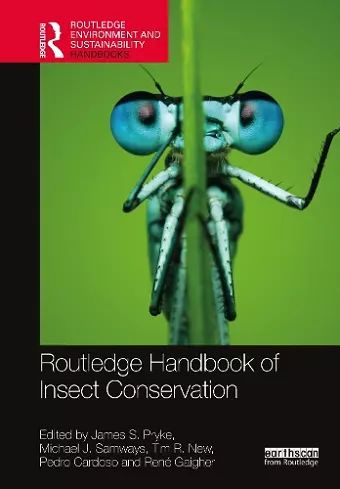Routledge Handbook of Insect Conservation
Michael J Samways editor Tim R New editor James S Pryke editor Pedro Cardoso editor René Gaigher editor
Format:Hardback
Publisher:Taylor & Francis Ltd
Published:14th Jun '24
Currently unavailable, and unfortunately no date known when it will be back

This handbook presents a comprehensive overview of insect conservation and provides practical solutions to counteract insect declines, at a time where insects are facing serious threats across the world from habitat destruction to invasive species and climate change.
The Routledge Handbook of Insect Conservation consist of six sections, covering all aspects of insect conservation, containing contributions from academics, researchers and practitioners from across the globe. Section I addresses the fundamentals of insect conservation and outlines the reason why insects are important and discusses the greatest drivers of insect decline. The chapters in Section II examine the approaches that can be used for insect conservation globally, such as protected areas and agroecology, while highlighting the importance of insects in the composition and function of ecosystems. The chapters in Section III focus on insect populations in the major biomes around the world, from temperate and tropical forests to savannas and grasslands, with the chapters in Section IV focusing on natural and manmade ecosystems of the world, including mountain, soil, urban, island and agricultural habitats. They discuss the unique pressures and challenges for each biome and ecosystem and offer practical solutions for conserving their insect populations. Section V focuses on the assessment and monitoring of insects for conservation, discussing how we can implement practical monitoring protocols and what options are available. A wide variety of methods and tools are examined, including citizen science, bioindication, the role of taxonomy, drones and eDNA. The book concludes by examining policy and education strategies for insect conservation in Section VI. The chapters discuss key issues around social and policy strategies and conservation legislation for ensuring the long-term protection of insects.
This book is essential reading for students and scholars of biodiversity conservation and entomology as well as professionals and policymakers involved in conservation looking for real-world solutions to the threats facing insects across the globe.
“…concern for the stability of insect populations worldwide has been a research focus of ecological and biodiversity entomologists for the past 25 years. This remarkable volume documents the activity of these scientists. Its diversity of topics is extensive, as one might expect in a text with more than 100 contributors…The stated goal is to provide “a practical handbook that will help guide conservation practitioners in finding solutions.” The volume accomplishes this goal. This text will serve as a primary reference in the field for many years and will be found in all libraries around the world that have significant entomology and biodiversity/conservation holdings. Summing Up: Essential. Advanced undergraduates through faculty.
CHOICE REVIEW, P. K. Lago, emeritus, University of Mississippi
ISBN: 9781032259505
Dimensions: unknown
Weight: 453g
562 pages